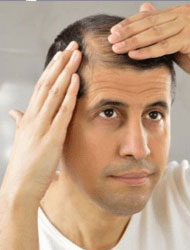laser treatment for hair loss
Consistently, the vast majority lose around 100 hairs from their scalp. While most individuals those hairs develop back, a few people don't due to the:
- age
- heredity
- hormonal changes
- medical conditions, for example, lupus and diabetes
- poor nourishment
- Side impacts of a clinical treatment, for example, chemotherapy
- stress

Medicines to stop going bald and conceivably turn around it include:
- medications, for example, minoxidil (Rogaine) and finasteride (Propecia)
- hair transplant surgery
- laser treatment
Low-level laser treatment (LLLT) — additionally referred to as red light treatment and cold laser treatment — illuminates photons into scalp tissues. These photons are consumed by frail cells to energize hair development.
It's generally acknowledged that the technique is protected, passable, and less obtrusive than a hair transplant procedure.
There are various reasons that people prefer this, which include:
- it's noninvasive
- it's easy
- there are no side effects
- it expands hair quality
There are various reasons that a few people are not as sure about the method, for example,
- It's time-consuming: To get results, treatment frequently requires a few meetings per week for various months. Even though the number of meetings may be reduced.
- It's costly. Clinical laser medicines for going bald can cost a good deal.
- It may not be powerful. The methodology gives off an impression of being less viable for individuals in the serious phases of going bald instead of those in the beginning phases.
- It can interact with specific prescriptions. Laser treatment ought not to be performed on individuals taking meds that are photosensitizing. Photosensitizing is a substance adjustment to the skin that expands somebody's affectability to light.
- Long-term security and adequacy have not yet been set up. Laser gadgets are delegated clinical gadgets by the FDA so they don't have a similar degree of investigation and testing that meds experience preceding endorsement. Long-haul well-being and long-haul adequacy have not yet been set up.
What are the various phases of going bald
Stage 1 Hair misfortune isn't huge. The downturn of the hairline isn't noted.
Stage 2 The hairline around the 2 temples of the brow becomes somewhat recessed. This speaks to a developed hairline.
Stage 3 Hair misfortune is clinically huge in this stage. The downturn of the hairline is essentially somewhere down in the temples. The temples will look like m/v or u design. The zone of downturn can be having a couple of dainty hair strands or totally a bare fix.
Stage 3 Vertex There is a huge thinning up top at the crown of the head (vertex). The hairline over the temples has a slight downturn in particular. (as in stage 2).
Stage 4 Hair is sparse or uncovered over the vertex. The hairline downturn over the temples is huge. There is a band of the scalp with typical hair in the middle of the zones of thinning up top.
Stage 5 The thinning up top is more unmistakable at the temples and crown. The band that isolated the 2 districts is still there, however, it has gotten thin when contrasted with stage 4. The hair in the band is scantier.
Stage 6 The band isolating the 2 zones of going bald is inadequate and insufficient. So the 2 territories of thinning up top of the crown and temples are joined.
Stage 7 This is the most serious stage. There is a band of hair in the scalp that has inadequate hair which circumvents the sides of the scalp.
Dr. Udaya Sarvani is the best hair care specialist in vijayawada for laser hair loss treatment.
